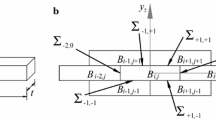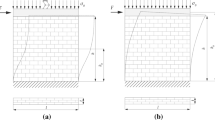Abstract
Forming new openings in load-bearing masonry panels is a frequent activity in engineering practice, often accomplished through very simplified design methods despite the complexity of the mechanical behaviour of the masonry and its interaction with the frame. Scientific literature and building codes provide little information. The Italian building code and the local regulation of Tuscany give some dimensional prescriptions and basic guidelines. Different simplified design methods in the literature lead to wide-ranging results. Here, the problem is approached through nonlinear finite-element analyses. The masonry is modelled through a rotating crack constitutive model, and the interaction between steel-frame and masonry, through cohesive-frictional interface elements. Sensitivity analyses are carried out by varying geometrical and mechanical parameters and the responses are compared in terms of capacity curves. The influence of the steel-profile cross-section, the position of the opening within the wall, and the degree of connection between the steel uprights and the masonry are evaluated. The study is extended to three-dimensional structures to determine the impact of the local operation of the opening formation on global behaviour. Based on the results obtained, some indications and guidelines are proposed.

































Similar content being viewed by others
References
Bartoli G, Betti M, Biagini P, Borghini A, Ciavattone A, Girardi M, Lancioni G, Marra AM, Ortolani B, Pintucchi B, Salvatori L (2016) Epistemic uncertainties in structural modeling: a blind benchmark for seismic assessment of slender masonry towers. ASCE J Perform Constr Facil 31(5):1–18
Battaglia R (2014) Rinforzi e/o introduzione di aperture - metodi di calcolo. Training course “Impariamo a ricostruire”, University of Ferrara
Berti M, Salvatori L, Spinelli P (2017) Unreinforced masonry walls with irregular opening layouts: reliability of equivalent-frame modelling for seismic vulnerability assessment. Bull Earthq Eng 15:1213–1239
Blasi C, Foraboschi P (1994) Analytical approach to collapse mechanisms of circular masonry arch. ASCE J Struct Eng 120(8):2288–2309
Calderoni B, Cordasco EA, Lenza P (2010) Structural behaviour of masonry spandrels of URM buildings subjected to horizontal loading: experimental analysis. Ing Sismica 27(4):49–70
Chiarugi A, Spinelli P (1991) Acciaio e riuso edilizio: il punto di vista strutturale. L’acciaio nel recupero edilizio e nel restauro—Repertorio delle soluzioni tecniche, Consorzio CREA, pp 39–48 (in Italian)
Ciavattini C (2012) Apertura vani in pareti portanti in zona sismica, Grafill (in Italian)
C.S.LL.PP (2008) Nuove Norme Tecniche per le Costruzioni. D.M. 14/02/2008 (in Italian)
Diana TNO (2008) DIANA-finite element analysis-user’s manual
Dolce M (1991) Schematizzazione e modellazione degli edifici in muratura soggetti ad azioni sismiche. L’Industria delle Costruzioni 242(12):44–57 (in Italian)
Foraboschi P (2016a) The central role played by structural design in enabling the construction of buildings that advanced and revolutionized architecture. Constr Build Mater 114:956–976
Foraboschi P (2016b) Versatility of steel in correcting construction deficiencies and in seismic retrofitting of RC buildings. J Build Eng 8:107–122
Foraboschi P (2017) Specific structural mechanics that underpinned the construction of Venice and dictated Venetian architecture. Eng Fail Anal 78:169–195
Foraboschi P, Vanin A (2013) Non-linear static analysis of masonry buildings based on a strut-and-tie modeling. Soil Dyn Earthq Eng 55:44–58
Gori L (2014) Il ruolo del Genio Civile nelle attività di protezione e di conservazione del costruito storico e degli edifici monumentali. In: Safe monuments. Collegio degli Ingegneri della Toscana (in Italian)
Jirasek M, Zimmermann T (1994) Analysis of rotating crack model. J Eng Mech 124(8):842–851
Lagomarsino S, Cattari S (2011) La realizzazione di nuove aperture nelle costruzioni in muratura esistenti. Training course of Ordine degli Ingegneri della Provincia di Bologna. March 4–5, Bologna, Italy (in Italian)
Laurenço PB, Senthivel R (2009) Finite element modelling of deformation characteristics of historical stone masonry shear walls. Eng Struct 31(9):1930–1943
Margiacchi F, Salvatori L, Orlando M, De Stefano M, Spinelli P (2016) Seismic response of masonry-infilled steel frames via multi-scale finite-element analyses. Bull Earthq Eng 14(12):3529–3546
Marra AM, Salvatori L, Spinelli P, Bartoli G (2016) Incremental dynamic and nonlinear static analyses for seismic assessment of medieval masonry towers. ASCE J Perform Constr Facil 31(4):1–10
M.II.TT (2009) Circolare 617/2009. Istruzioni per l’Applicazione delle Nuove Norme Tecniche di cui al D.M. 14/02/2008. G.U. n. 47 26/02/2009, S.O. n. 27 (in Italian)
Orlando M, Salvatori L, Spinelli P, De Stefano M (2016) Displacement capacity of masonry piers: parametric numerical analyses versus international building codes. Bull Earthq Eng 14:2259–2271
Pugi F (2012) Aperture e cerchiature in murature portanti con telai in acciaio e in calcestruzzo armato, Alinea (in Italian)
R.T (2010) Comitato Tecnico Scientifico in materia di rischio sismico. Orientamenti interpretativi in merito a interventi locali o di riparazione in edifici esistenti, Regione Toscana (in Italian)
Salvatori L, Spinelli P (2018) Continuum-discrete multiscale model for in-plane mechanical modeling of masonry panels. J Multiscale Model 9(2):1–25. https://doi.org/10.1142/S1756973718400048
Salvatori L, Marra AM, Bartoli G, Spinelli P (2015) Probabilistic seismic performance of masonry towers: general procedure and a simplified implementation. Eng Struct 94:82–95
Salvatori L, Marra AM, Bartoli G, Spinelli P (2017) Role of correlation between mechanical parameters in the probabilistic seismic vulnerability of historical masonry towers. Int J Mason Res Innov 2(2–3):134–149
Vignoli A, Chiostrini S (1999) Caratterizzazione meccanica delle murature in pietra della Lunigiana e della Garfagnana. DICEA, Firenze (in Italian)
Author information
Authors and Affiliations
Corresponding author
Additional information
Publisher's Note
Springer Nature remains neutral with regard to jurisdictional claims in published maps and institutional affiliations.
Rights and permissions
About this article
Cite this article
Billi, L., Laudicina, F., Salvatori, L. et al. Forming new steel-framed openings in load-bearing masonry walls: design methods and nonlinear finite element simulations. Bull Earthquake Eng 17, 2647–2670 (2019). https://doi.org/10.1007/s10518-018-00538-4
Received:
Accepted:
Published:
Issue Date:
DOI: https://doi.org/10.1007/s10518-018-00538-4




